Advantages and disadvantages
Wood putty has a number of significant advantages:
- The surface layer counteracts the penetration of moisture into the wood material, which means that it increases the service life of the structure.
- Smoothes out irregularities and cracks, hides knots that are always present in the tree.
- Improves the color rendering of the wood surface. The material can be used for painting and covered with decorative varnish.
- Hides wood defects that have arisen over the years.
- Does not emit harmful chemicals in the room.
- It is not affected by the temperature difference in the room.
- Effectively fills voids in wood material.
- Does not crumble or crack over time.
- Dries quickly.
Main varieties There are several types of putty in composition:
- Water based. Environmentally friendly product is harmless to living organisms. Plastic and odorless. To remove excess mixture, no aggressive solvent is needed, just take a damp cloth and wipe up the places where the putty has accumulated. The water putty can be stored for a long time in a sealed sealed container, for example, a can. Even in case of depressurization, the putty does not lose its properties for a long time.
- Oil mixture. Easily handles surfaces and is presented ready-to-use. Volumetric containers allow you to handle fairly large areas. Inexpensive and highly demanded mixture.
- Polymeric. It is used for any construction work both outside and inside structures. Has increased plasticity compared to other putties. Withstands loads and sudden changes in temperature.
Differences between putties for interior and exterior work Any type of putty for wood must meet the following requirements:
- moisture resistance;
- effective leveling of uneven terrain;
- exclusion of drying out of wood;
- high degree of adhesion of the product;
- improving the structure of the tree and emphasizing its natural texture.
Manufacturers of putty materials strive to ensure that the mixtures produced meet all these requirements, but still there is no universal wood putty that would be suitable for indoor and outdoor work at the same time.
Rules for applying putty on wood So that the result of construction work does not disappoint, you should adhere to certain rules for handling the leveling material:
- External work with wood putty must be performed at an ambient temperature of at least + 5 degrees Celsius. If this requirement is not met, the mixture may not completely fill voids and cracks in wooden structures. Air humidity must be at least 75%.
- The work surface must be carefully prepared. To do this, remove the remnants of the old coating, clean and wipe off dust. Then sand the surface to improve adhesion.
- Work on the application of the coating material is carried out with a plastic or stainless steel trowel or trowel.
- If there is a joint or crack on the surface with a depth of 1 - 2 centimeters, then it is better to cover it up in several layers, each 3 mm thick. Allow the previous coat to dry well before applying the next coat.
You can do it yourself if you want to putty for wood. It is not difficult at all, although it will take additional time. The recipe is pretty simple - shredded chalk and PVA glue, diluted to a thickness of 20 percent sour cream.
Colors If the putty is applied to a new tree only at the beginning of the renovation, this is one question. In this case, the color of the material is selected based on the calculation of the future interior. But there are times when you have to carry out local restoration work. Then the work with the selection of the color solution is complicated.
There are several ways to adjust the desired shade of putty for a wooden surface:
- The most common option is to buy a mixture of the color that suits the room.
- You can purchase a material in one shade and add pigment to it to get the color you want. Only the pigment will also have to be bought.
- Wait until the putty applied to the area of the wooden surface dries up and paint it in the desired color. This option is often used for filler wood flooring.
The presented range of mixtures allows you to choose the desired color, but at the same time, it should be borne in mind that when completely dry, the mixture may give a slightly different color, different from the original.
No. 7. Major manufacturers of putties
The putty market today is oversaturated - you can find a mixture of any composition, for any type of surface and, most interestingly, at almost any price. We all love to save money, especially when it seems that there is no difference at all between two similar products. When it comes to putties, saving does not seem such a sensible thing, because hardly anyone wants the putty layer to crack and fall off along with the paint after a few months. Trusting the products of large manufacturers is better:
- Knauf is a large German company with factories located all over the world, incl. in Russia, which allows us to buy quality products at more affordable prices. Knauf putties are presented in cement, gypsum and polymer compositions, sold in dry and ready-made form. There are solutions for all areas of use. A special solution of the company is a gypsum plaster with components that protect against X-ray radiation;
- Ceresit is a product of a large concern that is very popular all over the world. Ceresit brand sells cement and polymer putties;
- Tikkurila is another well-known concern that, among other things, produces putties. The company offers acrylic moisture resistant and gypsum compounds. Also in the assortment there is Euro Filler Light putty, which is distinguished by its ease of application and the absence of the need to sand - the surface itself becomes even. The color of the composition can be chosen from 15 offered. The company also offers Spakkeli wood putty, which is suitable for processing doors, furniture and other wooden surfaces indoors;
- Vetonit offers polymeric, cementitious and organic bonded fillers. There is a composition that will not only align the seams on drywall, old painted surfaces and wallpaper, but also allow you to create a textured decorative surface;
- Kreisel is a German company with factories in 20 countries, incl. in Russia. Putties are represented by cement and gypsum compositions;
- "Prospectors" - home-made putties. The quality is not bad, the prices are reasonable. The assortment is represented by gypsum, cement, polymer-cement and polymer compositions, which are suitable for starting and finishing works in dry and wet rooms, as well as for outdoor work;
- Volma is another domestic manufacturer that has proven itself well. The range of compositions is very wide. There are gypsum and polymer putties with different particle sizes. There are solutions for any situation.
You can also recommend the products of "Ural building mixtures", "ARMstrong" and "Eurogypsum".
When buying, do not forget to inspect the integrity of the packaging, pay attention to the expiration date and, if desired, ask for certificates of conformity - any responsible manufacturer and seller should have them
Arguments in favor of putty
A wide variety of wood products are putty, including old window frames, new hard and soft wood joinery, parquet, etc.
Puttying wood allows you to get the following advantages:
- A layer of putty prevents moisture from absorbing into the material, which results in an increase in the service life of the wooden product.
- Thanks to the putty mixture, it is possible to mask all sorts of surface defects, such as knots, cracks, chips.
- When the coating dries, it remains completely translucent, which allows it to maintain the appearance of the natural wood structure.
- Parquet putties come into close contact with the floor material, filling all its unevenness, and also prevent dirt.
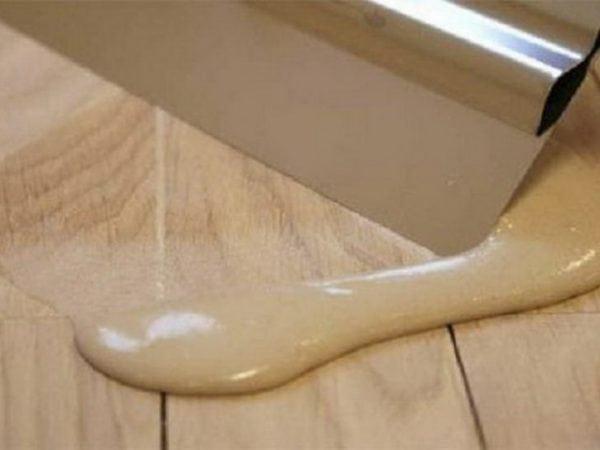
The main argument against plastering wood is the argument that the material will swell when exposed to moisture. It should be noted that all mixtures intended for wood impart moisture resistance to the wood surface. Thus, if the putty is chosen correctly, the fears are unfounded.
Manufacturers
In order not to be mistaken when buying a putty, it is worth choosing products from well-known manufacturers:
- On the territory of Russia, the VGT company is one of the three leaders in terms of production of paints and varnishes. The company has been supplying a wide range of high quality building materials to the Russian market since 1992. All products of the company have appropriate quality certificates.
- Parade is a major manufacturer of finishing materials. The main feature of the products of this enterprise is environmental friendliness. Finishing materials are made only from high quality imported raw materials using the latest technologies. Products undergo strict quality control at every stage of the production process.
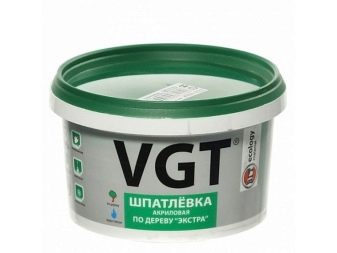
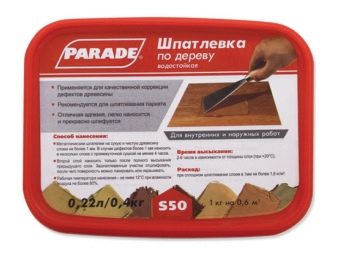
All paint and varnish products have quality certificates and can be used in medical institutions. Parade is the first organization in Russia that has the right to use the 100% EcoQuality label
- Plant "Raduga" is a leader in the manufacture and sale of paints and varnishes. The products of this company are widely demanded in different regions of the world. In addition to high quality products, LC "Raduga" offers a high level of customer service. The company's employees are ready to develop a new product, in accordance with the specific requirements of the customer.
- The Olimp enterprise sells its products in Russia and the CIS countries, successfully competing with well-known Russian and foreign brands. Paints and varnishes are manufactured using the most modern equipment from high quality European raw materials. The employees of the organization strictly control the quality of raw materials and finished products, and also actively introduce the latest technologies into the production process.
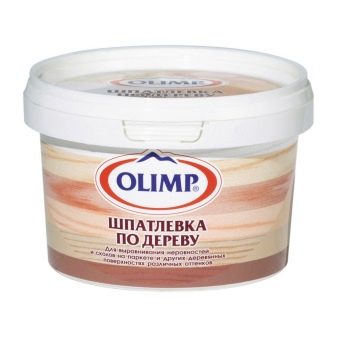
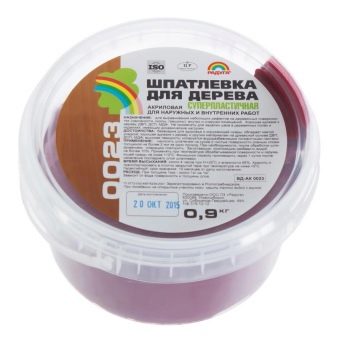
- The Lakra company produces paints and varnishes in Europe and Russia using modern Western technologies. All products manufactured by these enterprises comply with world quality standards. The Lakra company is one of the three leading manufacturers of paints and varnishes in Russia.
- Other large manufacturers of wood putty include: Bostik, PHZ, Tikkurila, Smes, Synteco. The products of these companies are also of high quality and are in great demand in the market of finishing materials.
Types and properties of putties for wood
In everyday life and in production, a variety of wood putties are used, which differ in their constituent components.The principle of operation of different materials is approximately the same - they interfere with the penetration of moisture into microcracks, recesses and holes, eliminate visible defects and prevent the base from becoming dirty. Most often, putties are used in the treatment of frames, doorways and canvases, flooring, skirting boards, plywood, etc.
Gypsum
Such putties are poorly suited for outdoor use, since they tend to strongly absorb moisture. In addition, in terms of strength and elasticity, they are inferior to many analogues. It is better to use such materials only for small areas that will not be exposed to aggressive environmental factors. They can also be used to seal up internal wooden bases in dry rooms. The advantages of gypsum putties are high vapor permeability, environmental friendliness, preservation of the natural microclimate in the house and a low price.
Acrylic
Acrylic putty is quite often used for woodwork. This material is non-toxic, does not emit a smell at all, and can be used for external and internal work. Waterproof acrylic putty is not afraid of moisture, temperature changes, moderate mechanical stress. It adheres reliably to the substrate and is suitable for treating floors and exterior walls of buildings. The composition can be filled up with both small cracks and wood pores, and deep defects in wood. After drying, high-quality acrylic fillers are characterized by low shrinkage and can be washed. Other advantages of acrylic-based materials are as follows:
- high aesthetic qualities;
- ease of application due to plasticity;
- elasticity and lack of cracking in the future;
- long service life;
- protection of boards from fire;
- the possibility of grinding after drying.
Non-shrinking composition for wood based on acrylic
Latex
Latex based putties are very flexible, easy to apply and leveled with a spatula. They are characterized by excellent adhesion to wood, firmly fixed on its surface and withstand further mechanical processing - planing, sawing, grinding, etc.
This group of materials can be used for indoor and outdoor work, since it is frost-resistant and does not deteriorate from temperature extremes. Latex putties are suitable for places with high humidity, and after drying can be painted in any shade. They can be used to process walls, structures, and can also be used to eliminate defects on furniture, doors, chipboard and fiberboard panels.
Polymer
Highly plastic polymer compounds allow to close even the deepest cracks in wood. They are characterized by:
- environmental safety;
- lack of shrinkage, flaking, cracking;
- preservation of quality under the influence of ultraviolet radiation;
- high speed of solidification and complete drying;
- long service life;
- protection of wooden surfaces from clogging, pollution;
- dust repelling.
Each polymer putty is heat and moisture resistant. This means that the composition is ideal for outdoor use, since it does not deteriorate from moisture, frost, and high temperatures.
Oil-based adhesive
Such compositions are made on the basis of oils, drying oil, adhesive components, plasticizers and solvents. They are suitable for treating facades before painting them. Oil-glue putty is a moisture-resistant mixture that does not deteriorate from the influence of precipitation, wind, frost and other adverse factors. It allows you to create a perfectly flat plane, suitable for processing large surfaces. Putty of this type is perfectly combined with other finishing materials.
Universal oil and glue mixture with antiseptic
Epoxy heat and moisture resistant
Epoxy putties are two-component compositions, one part of which contains epoxy resin, pigments, and the other contains a hardener with plasticizers. After mixing and applying the product, the most durable, durable and damage-resistant coating for wood is formed. It is not afraid of deformation, does not crack, does not shrink. Epoxy does not deteriorate from water at all, literally repels precipitation, tolerates repeated freezing and defrosting. The finished coating can be painted and sanded. The only drawback of epoxy putty is the high price.
Homemade putty
If you wish, it is quite possible to make a putty for wood with your own hands. There are several common recipes, which will be discussed in more detail below.
A mixture of PVA and chalk
This solution is considered the simplest.
It is made as follows:
- Mix well crushed chalk with PVA.
- Bring the mixture to a homogeneous consistency, reminiscent of sour cream.
- Add a little sawdust if you need to seal the joints.
After treatment with a solution of chalk and PVA, the coating dries in about 24 hours.
A mixture of chalk and water-soluble varnish
The cost price of such a solution is even lower than the previous one. The manufacturing technology is the same as described above, but you will need a water-soluble varnish. In this case, the coating is more durable and elastic. The desired color can be obtained by adding a color scheme. The putty is suitable for wood-shaving and orienting-strand boards.
A few helpful tips:
- It is better to start cooking in the evening, so that by the morning you have a ready-made putty.
- If the solution turns out to be thick, it can be diluted with a little water.
- For the base layer, you can add sawdust.
- Drying period is about 12 hours.
A mixture of oil and drying oil
To make the putty, you will need the following components:
- linseed oil - 280 grams;
- turpentine oil - 60 grams;
- pumice powder - 30 grams;
- casein - 20 grams;
- gelatin - 20 grams;
- 18% ammonia solution - 18 grams;
- borax - 12 grams.
The solution is made in the following order:
- Mix the pumice stone and oil.
- Add 300 grams of water to the mixture.
- We mix the remaining components one by one.
- We heat the solution in a water bath to 90 degrees Celsius.
- Stir the mixture thoroughly to obtain a homogeneous structure.
- When the solution acquires a pasty consistency, it can be considered ready.
- After removing from heat, the mixture should be allowed to cool slightly.
A mixture of oil and varnish keeps working characteristics for an hour.
A mixture of sawdust, chalk and nitro varnish
Wood putty based on chalk, sawdust and nitro varnish is used only in non-residential premises and for finishing facades. The disadvantage of this mixture is the presence of a specific odor, which comes even from a long-dried coating. The reason for the smell is nitro lacquer. At home, making an odorless solution will not work. The composition is made in the same way as the previous putties - until a creamy paste is obtained.
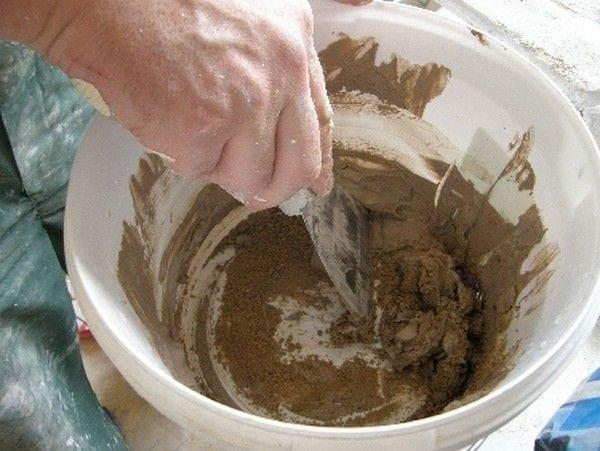
Characteristics of materials for outdoor use
To eliminate external defects and treat the walls of the building from the outside, a facade putty is used. Specialty stores offer a huge selection of these materials, all of which are waterproof.
The function of the composition is to protect the facade of the building from the adverse effects of weather conditions.
All putty mixtures are divided into two types:
- Starting.
- Finishing.
The starting option is used at the initial stage of the repair. This is a rough finish. Such a mixture has a coarse-grained structure, it is easy to grind, and is characterized by a high adhesion rate. Its cost is much lower than that of the finishing. Therefore, for the sake of saving on the purchase of finishing materials, it is in your interests to correctly align the base at the initial stage of work.
How to apply the putty:
The finish has a fine grain structure and is sold in bags (dry version) and plastic buckets (off-the-shelf). This type of material is environmentally friendly, moisture resistant, elastic, breathable. At the same time, he is not afraid of frost.
Operating procedure
The first stage is the preparation of the wooden surface for work. Before you prepare the room, free the surface to be treated and everything around. The window frame on the street does not require special preparations, but do not forget about safety when working at height. Need a second person for insurance. Put on a mask and gloves. What you are going to putty depends on how you will clean your wooden surface.
Before puttying, the wood needs to be prepared
Tools for preparatory work:
- metal spatula (helps to remove old paint from the surface);
- sandpaper (clean the surface);
- solvent (there are mixtures that corrode paint);
- building hair dryer (it is possible by heating the surface to facilitate the removal of the old coating);
- pliers - remove nails or staples, if any (otherwise, rust may appear after staining);
- brush (to apply the solvent);
- brush and kitchen sponge (for residual cleaning of the smallest particles and dust).
Before starting work, prepare all the tools you need. The second stage is priming. In order to protect the wood from rotting and fungus, to improve the adhesion of the surface and the future coating (paint, varnish), it is necessary to prime it. There are special primers based on acrylic, alkyd or mineral base. We choose a mixture based on which corresponds to the putty. For the process, we need the following tools:
- capacity (for primer);
- brush or roller (for application).
We carefully prime the entire surface to be painted with a brush or roller. We give time for everything to dry.
The tree needs to be primed to protect it from fungus
The main stage. Using a rubber spatula, apply the putty to the wooden surface with a primary layer of 2-3 mm. Let it dry. We clean the surface. We putty again, with a more liquid mixture. Layer thickness 1.5 mm. Putty on wooden surfaces requires diligence and patience. But the efforts made will reward you with a perfectly glossy finish, ready for painting.
Instruments:
- rubber spatulas of various sizes (sold as a set)
- spray gun (applies liquid mixture on the parquet floor)
- sandpaper (sanding the surface)
Apply the putty with a rubber spatula
Types of putty for interior work
There are many types of putties for indoor finishing. Their choice entirely depends on the type of surface to be treated, as well as on the financial capabilities of everyone who decides to engage in finishing work. For example, the price category of epoxy and polymer materials can vary significantly.
Acrylic
Such material is produced exclusively through the use of chemical components. Acrylic putty on wood, after complete drying, forms a sufficiently strong but elastic layer. It lends itself well to post-processing. It doesn't take too much effort to sand it.
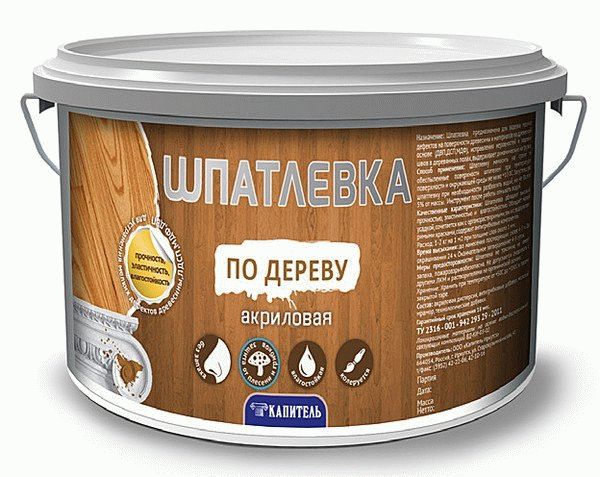
It is believed that this type of putty is the most environmentally friendly. That is, its effect on the human body is practically not observed. Can be used to finish any type of surface. This can be very convenient, because you do not need to select your own composition for each material. Not suitable for sealing large joints and cracks. It is believed that the optimal layer thickness cannot be more than 2-3 mm.
Epoxy
This type of putty is used to close and level any imperfections that may be on wood surfaces. This versatility is achieved due to the fact that the epoxy putty has excellent adhesion and does not require effort to apply.
It has the following advantages:
- epoxy dries quickly enough;
- does not require special tools for work;
- you can putty it any flaw;
- after complete drying, it is polished;
- epoxy putty is moisture resistant;
- practically does not interact with chemicals;
- full adhesion to all groups of materials.
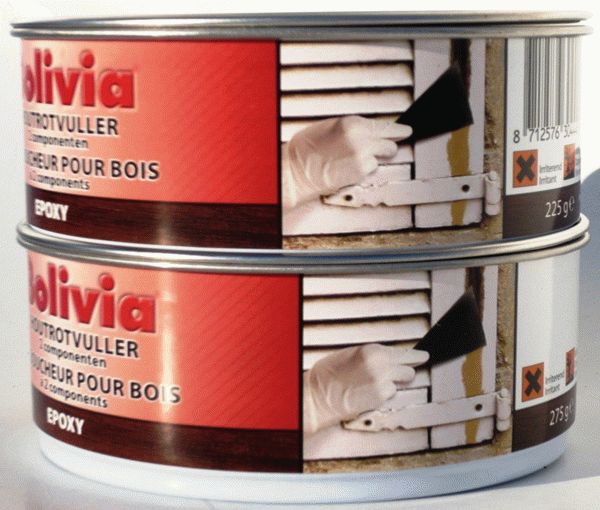
Fillers are added to epoxy mortars to achieve the greatest effect. They impart increased viscosity. How much to add such a substance to the composition is calculated only locally.
Gypsum
It differs from other putties in that it forms an elastic and white layer after application. Doesn't require any special skills to carry out the work. It adheres perfectly to wooden structures. It can be used as a starting or finishing lineup.
This putty is intended exclusively for interior work.
Polymer
This is a fairly modern material. It contains various polymer components. It depends on them what qualities the composition will have. This putty is perfect for all stages of work. She:
- perfectly masks the seams;
- closes even the deepest cracks;
- well suited for subsequent finishing work, such as painting, varnishing;
- eliminates cracks that form from water penetration.
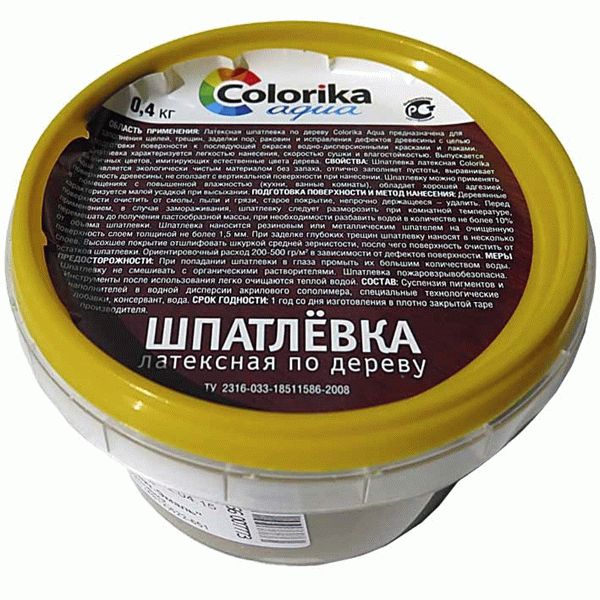
There are mainly acrylic (mentioned above) and latex compositions. The first ones are used much more often. The latter, possessing unique properties, are quite expensive.
Oil and glue
This putty is used to correct numerous defects that form on window frames, ceilings, doors and frames. Not used for floor work. Possessing a wide palette of shades, no additional color is needed. The only significant drawback is the long drying time.
Waterproof
An excellent option for those rooms where there is high humidity. That is, such a putty is suitable for bathrooms, kitchens. Possessing increased moisture resistance, it is not subject to harmful effects. Excellent for subsequent painting.
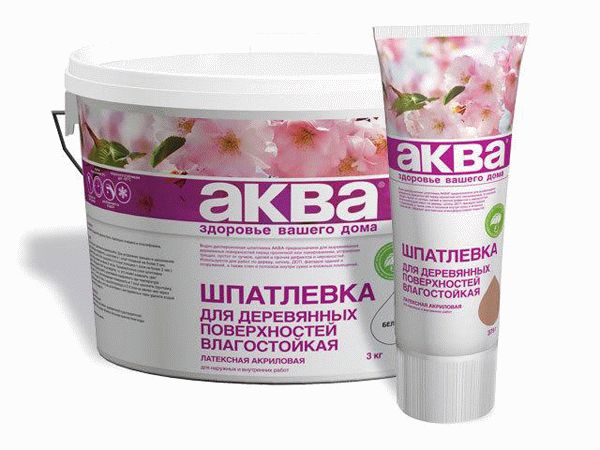
Application rules
The wood, on which the putty will be applied, is roughly sanded, then dust is removed from it with a brush and a rag, and even better, blow it off from a pneumatic gun. Next, apply with a spatula with a small slide to the flaw. No matter how the manufacturers praise their goods, the putty shrinks when it dries.


The primer solves this problem, but the adhesion of the putty to the primed wood is noticeably worse. It is advisable to keep the spatula clean - this will simplify the work. If it is necessary to apply a thick layer, it must be done in several passes, allowing the intermediate layers to dry. After drying, the excess filler is removed with sandpaper.

